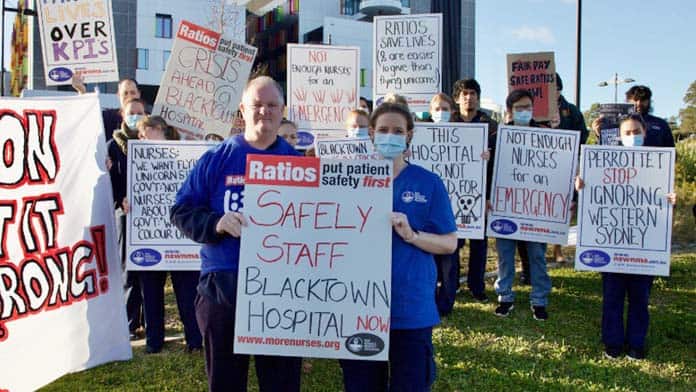In a fantastic show of rank-and-file anger, NSW nurses have reaffirmed their decision to demand a 7 per cent pay increase, rejecting the NSW Liberal government’s pay cap (read pay cut) of just 3 per cent, as well as rejecting the recommendation from their officials that they accept it. At Royal Prince Alfred hospital, the vote was 73 per cent in favour of campaigning for both 7 per cent and shift ratios.
The vote, from a majority of nurses and a majority of branches, reaffirmed the vote taken by hundreds of nurses at a mass meeting at Sydney Town Hall on 28 June called to discuss the union’s campaign for nurse-to-patient ratios and pay.
The branch-by-branch vote, declared yesterday, was a solid back-up to the 28 June mass meeting that saw more than 70 of the roughly 180 public sector branches of the NSW Nurses and Midwives Association vote to stop work, for periods ranging from two hours to 24 hours.
It was the third day of strike action nurses have taken this year.
The meeting voted, “to continue the fight for shift by shift ratios and fair pay through sustained and escalating industrial action.”
It also backed an amendment to the official motion calling for a 7 per cent pay raise.
The Reserve Bank predicts inflation will be at 7 per cent by the end of the year. Pay cuts are one reason experienced nurses are being driven out of the profession—20,000 nurses quit last year.
To fix the crisis in health system staffing, workloads and pay must be dealt with together.
Even before the meeting, the union’s acting assistant general secretary, Michael Whaites, told The Sydney Morning Herald that the one-off “thank you” payment of $3000 for health staff did not offset a “real pay cut under the new 3 per cent wages policy”.
But, following the meeting, the union sought to overturn the vote for a 7 per cent pay rise. General Secretary Brett Holmes emailed all union members declaring that another vote would be held on the demand for 7 per cent branch-by-branch, due to technical difficulties for those using online voting at the mass meeting.
The leadership wanted to accept the NSW government’s 3 per cent pay offer, or 2.53 per cent plus a superannuation increase, in an effort to get a one year agreement at the Industrial Relations Commission (IRC).
This was designed to allow another negotiation on wages next year, in the hope Labor wins the state election in March.
But, following the vote to reaffirm the demand for 7 per cent, the union rightly emailed members, arguing, “The IRC is not where we will win a 7 per cent increase… We will only win our shift by shift ratios claim and a fair pay increase of at least 7 per cent by taking further action, and by continuing to do so until the government agrees.”
The decision to reaffirm the pay claim is an indication of the anger amongst nurses at the disrespect shown them by the Liberal government, and their failure to fix the hospital system after more than two years of the pandemic.
Branches now need to call on the union’s council to set the date for the next day of industrial action.
Public sector-wide action
The industrial action across the public sector by nurses, teachers and public servants has Liberal Premier Dominic Perrottet on the back foot.
The train drivers’ industrial campaign has forced the government to finally back down on safety and staffing concerns on the new intercity fleet.
But with all the major public sector unions in NSW campaigning against the state Liberal government, now is the time to step up the industrial campaign, not step back.
The next step should be setting a date for a nurses, teachers and public sector-wide strike and stopwork rally in early August.
There is no point relying on the election of a Labor government at the state election in March next year.
NSW Labor leader Chris Minns has said nothing about supporting above-inflation wage rises or cutting teachers’ workloads. He has called on the rail workers to end their industrial action.
In May, he refused to support the nurses’ demand for enforceable nurse-to-patient ratios.
There is massive community support for nurses. People know the sacrifices that nurses have made to keep the health system going during the pandemic.
Electing a Labor government next March is not going to fix the problems. We need more staff and pay rises now.
That means organising for a united public sector-wide stopwork rally to win action on ratios, staffing, workloads and a real, above-inflation pay increase. A concerted industrial campaign can win nurses’ demands.
Sign and share a petition calling for a NSW public sector-wide strike here.






